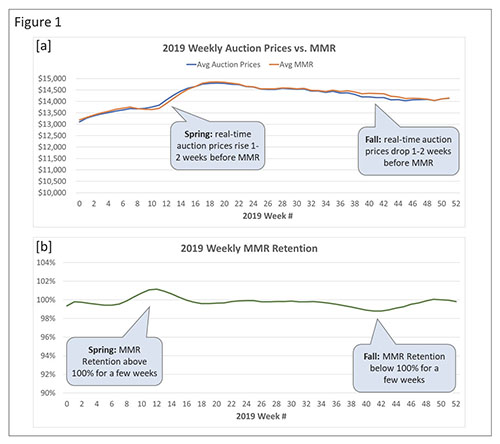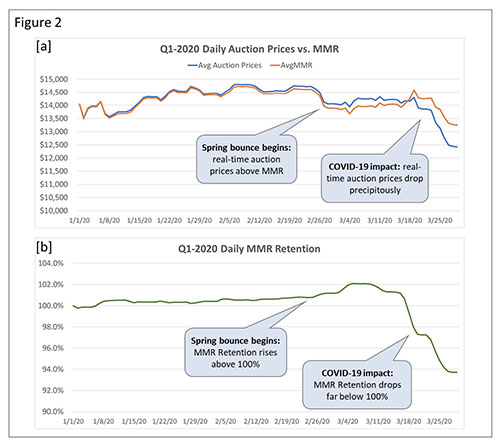Using MMR Retention in combination with MMR itself can help guide business decisions during these turbulent times.
See the new daily MMR Retention trend on Manheim.com.
April 2, 2020
By Dr. Benjamin Flusberg, associate vice president, M LOGIC
The Manheim Market Report (MMR) is the industry’s most trusted source of wholesale vehicle values and is used by tens of thousands of consignors and dealers each month to value millions of used vehicles.
In normal times, wholesale transaction prices tend to change gradually over weeks and months, and MMR tracks these changes extremely well. But with COVID-19 and the sweeping effects it’s having on the economy and automotive industry, we aren’t in normal times.
It’s not surprising, then, that I’ve received numerous inquiries about MMR over the past few tumultuous weeks. In this unprecedented time, I know consignors and dealers are looking for guidance in making the right business decisions, from setting competitive floor prices and deciding on maximum bid prices at auction to accurately assessing trade-in values.
To understand how this gold standard valuation tool can be used with confidence during the current volatile market, let’s take a look at how MMR works:
How Does MMR Perform in Typical Markets?
MMR is intentionally designed to be highly stable and avoid over-reacting to short-term market ups and downs. During typical market inflections, such as the seasonal spring bounce, MMR reacts smoothly and takes a couple of weeks to fully normalize to new market conditions. A great way to measure this normalization is by comparing average auction transaction prices to MMR values – we call this metric MMR Retention.
To get a sense for how MMR reacts to typical market swings, let’s look back at MMR Retention – along with its underlying auction sale prices versus MMR – across all Manheim transactions throughout 2019:

As you can see in Figure 1, MMR Retention is almost exactly 100% during steady markets, but it varies up or down by 1-2% during typical seasonal inflections, like the spring bounce and fall decline. During these time periods, it usually takes MMR a couple of weeks to fully catch up.
How Does MMR Perform in a Volatile Market?
During the past few weeks, the changes in the wholesale market have been unprecedented in their abruptness and magnitude. Driven by constrained retail demand, auction sales rates and volumes have dropped dramatically. Auction transaction prices, reflecting this supply-demand imbalance, have in turn fallen precipitously. MMR has fallen, too, but by design not as steeply. As a result, MMR Retention has dipped significantly below 100% in recent days (Figure 2).

Why is the difference between MMR and real-time auction sale prices much larger right now than during typical market inflections? I believe there are three reasons:
Unlike other benchmarks, MMR is based purely on statistics: the marketplace tells us what MMR is, that is, we follow the data without introducing human subjectivity into the values. MMR is intentionally designed not to have a knee-jerk reaction to extremely unusual events like we’re experiencing now. As this volatile market stabilizes, I expect MMR to re-normalize to real-time transaction prices and MMR Retention to return to 100%.
How to Use MMR to Guide Used Vehicle Business Decisions During Turbulent Times
Our goal is to keep the automotive industry moving forward during this unprecedented time. Manheim and other Cox Automotive companies have taken numerous steps to help our clients and partners keep the automotive marketplace up and running. To help clients better assess vehicle values, starting this week and until the wholesale market stabilizes, Manheim will publish daily views of MMR Retention on the Manheim.com website: https://publish.manheim.com/en/whats-new/daily-mmr-retention.html Using MMR Retention in combination with MMR itself can help guide business decisions during these turbulent times.
As I mentioned, right now MMR Retention is lower than 100%, which means that real-time values are less than MMR. For example, if MMR for a given vehicle is $10,000 and today’s MMR Retention is 95%, then the vehicle’s value is around $9,500. Consignors who want to sell cars should set floor prices based on a $9,500 value. With limited demand in today’s market, it’s more important than ever to price vehicles properly using data-driven metrics like MMR and MMR Retention.
Why Can’t You Speed Up MMR’s Reaction Time?
As the industry’s standard for wholesale valuations, relied upon by so many industry partners, it’s important that we maintain MMR’s robustness with the long-term in mind. Over the past few days, many people have asked me, “Can’t you improve MMR’s reaction time by weighting recent transactions even more heavily than you already do?”
It’s true that doing so might reduce MMR’s lag in today’s rapidly changing environment, but it would come at the cost of reduced stability and false-positive swings in MMR – even during normal times. So, in these extraordinary times and until the market stabilizes, I recommend pricing your used-vehicle inventory based on both MMR itself and MMR Retention.
Dr. Benjamin Flusberg is associate vice president of M LOGIC, a suite of decisioning tools from Manheim that brings the power of Manheim and Cox Automotive data, tools and insights to help clients make smarter, real-time decisions and take action for faster inventory turns at every step of the wholesale life cycle.